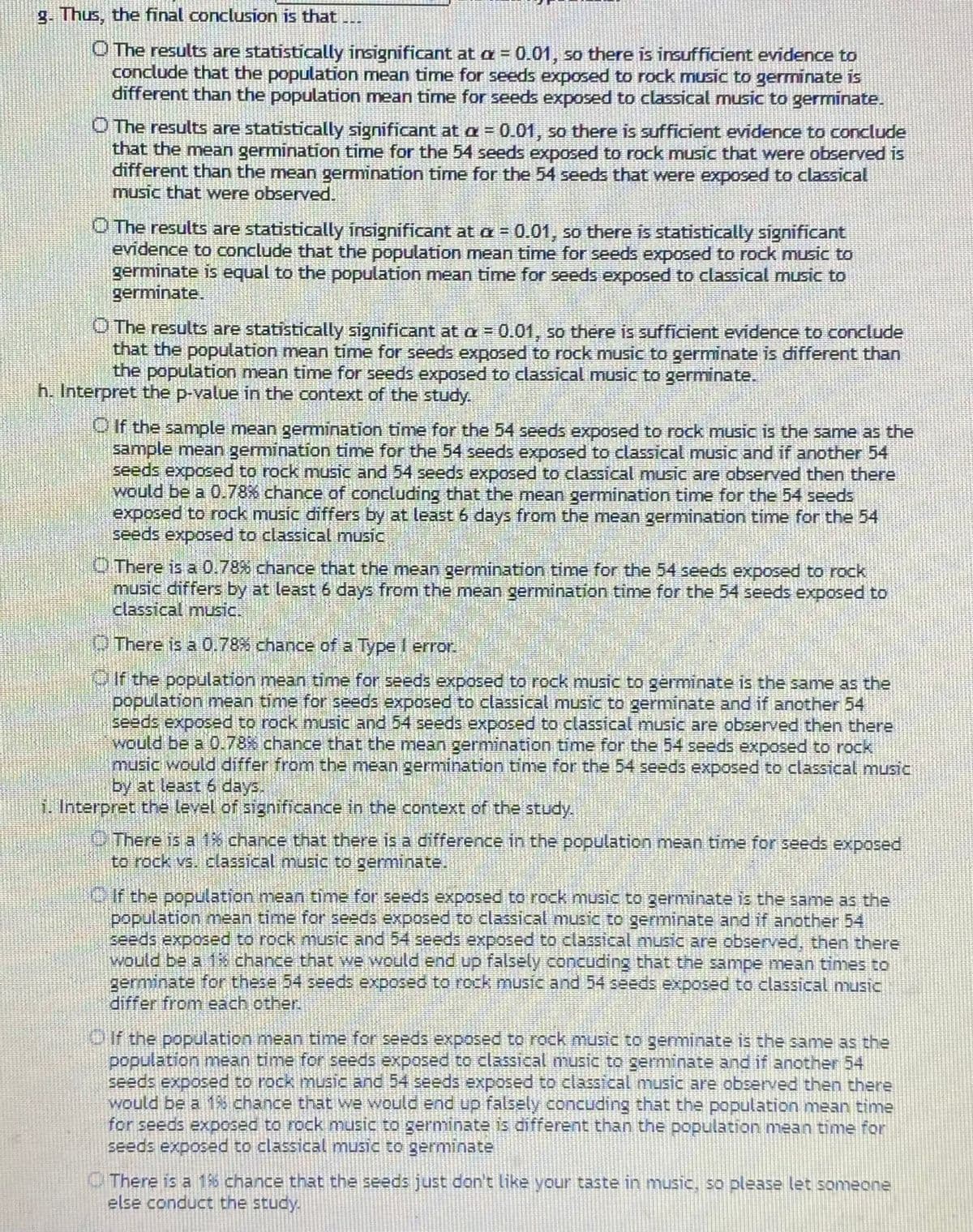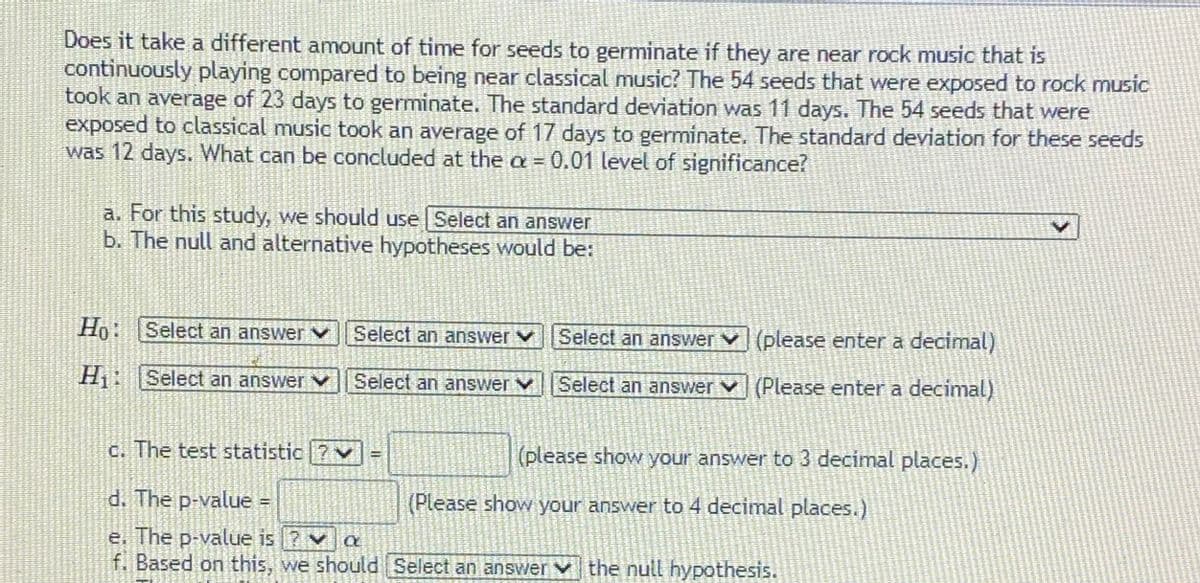Does it take a different amount of time for seeds to germinate if they are near rock music that is continuously playing compared to being near classical music? The 54 seeds that were exposed to rock music took an average of 23 days to germinate. The standard deviation was 11 days. The 54 seeds that were exposed to classical music took an average of 17 days to germinate. The standard deviation for these seeds was 12 days. What can be concluded at the a = 0.01 level of significance? a. For this study, we should use Select an answer b. The null and alternative hypotheses would be: Ho: Select an answer V Select an answer V Select an answer v(please enter a decimal) H: Select an answer Select an answer vSelect an answer v (Please enter a decimal) c. The test statistic ? v = (please show your answer to 3 decimal places.)
Does it take a different amount of time for seeds to germinate if they are near rock music that is continuously playing compared to being near classical music? The 54 seeds that were exposed to rock music took an average of 23 days to germinate. The standard deviation was 11 days. The 54 seeds that were exposed to classical music took an average of 17 days to germinate. The standard deviation for these seeds was 12 days. What can be concluded at the a = 0.01 level of significance? a. For this study, we should use Select an answer b. The null and alternative hypotheses would be: Ho: Select an answer V Select an answer V Select an answer v(please enter a decimal) H: Select an answer Select an answer vSelect an answer v (Please enter a decimal) c. The test statistic ? v = (please show your answer to 3 decimal places.)
MATLAB: An Introduction with Applications
6th Edition
ISBN:9781119256830
Author:Amos Gilat
Publisher:Amos Gilat
Chapter1: Starting With Matlab
Section: Chapter Questions
Problem 1P
Related questions
Question

Transcribed Image Text:g. Thus, the final conclusion is that
O The results are statistically insignificant at a = 0.01, so there is insufficient evidence to
conclude that the population mean time for seeds exposed to rock music to germinate is
different than the population mean time for seeds exposed to classical music to germinate.
O The results are statistically significant at a = 0.01, so there is sufficient evidence to conclude
that the mean germination time for the 54 seeds exposed to rock music that were observed is
different than the mean germination time for the 54 seeds that were exposed to classical
music that were observed.
O The results are statistically insignificant at a = 0.01, so there is statistically significant
evidence to conclude that the population mean time for seeds exposed to rock music to
germinate is equal to the population mean time for seeds exposed to classical music to
germinate.
O The results are statistically significant at a = 0.01, so thére is sufficient evidence to conclude
that the population mean time for seeds exposed to rock music to germinate is different than
the population mean time for seeds exposed to classical music to germinate.
h. Interpret the p-value in the context of the study.
OIf the sample mean germination time for the 54 seeds exposed to rock music is the same as the
sample mean germination time for the 54 seeds exposed to classical music and if another 54
seeds exposed to rock music and 54 seeds exposed to classical music are observed then there
would be a 0.78% chance of concluding that the mean germination time for the 54 seeds
exposed to rock music differs by at least 6 days from the mean germination time for the 54
seeds exposed to classical music
O There is a 0.78% chance that the mean germination time for the 54 seeds exposed to rock
music differs by at least 6 days from the mean germination time for the 54 seeds exposed to
classical music.
OThere is à 0.78% chance of a Type I error.
OIf the population mean time for seeds exposed to rock music to gérminate is the same as the
population mean time for seeds exposed to classical music to germinate and if another 54
seeds exposed to rock music and 54 seeds exposed to classical music are observed then there
would be a 0.78% chance that the mean germination time for the 54 seeds exposed to rock
music would differ from the mean germination time for the 54 seeds exposed to classical music
by at least 6 days.
1. Interpret the level of significance in the context of the study.
OThere is a 1% chance that there is a difference in the population mean time for seeds exposed
to rock vs. classical music to germinate.
OIf the population mean time for seeds exposed to rock music to germinate is the same as the
population mean time for seeds exposed to classical music to germinate and if another 54
seeds exposed to rock music and 54 eeds exposed to classical music are observed, then there
Would be a 18 chance that we would end up falsely concuding that the sampe mean tinmes to
germinate for these 54 seeds exposed to rock music and 54 seeds exposed to classical music.
differ from each other.
Oif the population mean time for seeds exposed to rock music to geminate is the same as the
population mean time for seeds exposed to classical music to germinate and if another 54
seeds exposed to rock music and 54 seeds exposed to classical music are observed then there
would be a 18 chance that we would end up falsely concuding that the population mean time
for seeds exposed to rock music to germinate is difrerent than the population mean time for
seeds exposed to classical music to germinate
O There is a 16 chance that the seeds just don't like your taste in music, so please let someone
else conduct the study.

Transcribed Image Text:Does it take a different amount of time for seeds to germinate if they are near rock music that is
continuously playing compared to being near classical music? The 54 seeds that were exposed to rock music
took an average of 23 days to germinate. The standard deviation was 11 days. The 54 seeds that were
exposed to classical music took an average of 17 days to germinate. The standard deviation for these seeds
was 12 days. What can be concluded at the a = 0.01 level of significance?
a. For this study, we should use Select an answer
b. The null and alternative hypotheses would be:
Ho: Select an answerV Select an answer v
Select an answer V
(please enter a decimal)
H: Select an answer v Select an answer V
Select an answer v (Please enter a decimal)
c. The test statistic ? v
(please show your answer to 3 decimal places.)
d. The p-value =
(Please show your answer to 4 decimal places.)
e. The p-value is ? va
f. Based on this, we should Select an answer v the null hypothesis.
%3D
Expert Solution
This question has been solved!
Explore an expertly crafted, step-by-step solution for a thorough understanding of key concepts.
This is a popular solution!
Trending now
This is a popular solution!
Step by step
Solved in 4 steps

Recommended textbooks for you

MATLAB: An Introduction with Applications
Statistics
ISBN:
9781119256830
Author:
Amos Gilat
Publisher:
John Wiley & Sons Inc

Probability and Statistics for Engineering and th…
Statistics
ISBN:
9781305251809
Author:
Jay L. Devore
Publisher:
Cengage Learning

Statistics for The Behavioral Sciences (MindTap C…
Statistics
ISBN:
9781305504912
Author:
Frederick J Gravetter, Larry B. Wallnau
Publisher:
Cengage Learning

MATLAB: An Introduction with Applications
Statistics
ISBN:
9781119256830
Author:
Amos Gilat
Publisher:
John Wiley & Sons Inc

Probability and Statistics for Engineering and th…
Statistics
ISBN:
9781305251809
Author:
Jay L. Devore
Publisher:
Cengage Learning

Statistics for The Behavioral Sciences (MindTap C…
Statistics
ISBN:
9781305504912
Author:
Frederick J Gravetter, Larry B. Wallnau
Publisher:
Cengage Learning

Elementary Statistics: Picturing the World (7th E…
Statistics
ISBN:
9780134683416
Author:
Ron Larson, Betsy Farber
Publisher:
PEARSON

The Basic Practice of Statistics
Statistics
ISBN:
9781319042578
Author:
David S. Moore, William I. Notz, Michael A. Fligner
Publisher:
W. H. Freeman

Introduction to the Practice of Statistics
Statistics
ISBN:
9781319013387
Author:
David S. Moore, George P. McCabe, Bruce A. Craig
Publisher:
W. H. Freeman